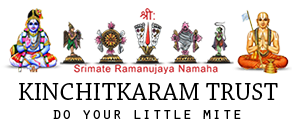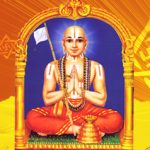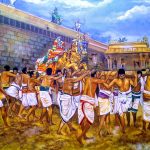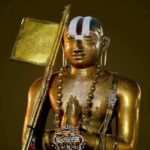ஶ்ரீ ரங்க நாச்சியார் சமேத ரங்கநாதன் திருவடிகளே சரணம்!ஶ்ரீமதே ராமநுஜாய நம: நமஸ்காரம்!அடியேனுக்கு ஒரு சந்தேகம். ஆதி அத்தி வரதர்,பிரம்மா நடத்திய யாகத் தீயில் இருந்து தானாகத் தோன்றியப் பெருமான்.அவர் ஒரு ஸ்வயம் வ்யக்தன்.அப்படிப்பட்டத் தானாகவே தோன்றியப் பெருமாள் வடகலை நாமத்தை தான் அணிந்து இருக்கிறார். மேலும் ,தேசிகன் ஒரு முறை தன்னுடைய விக்ரஹத்தை தானே செய்ய நேர்ந்தது. அந்த விக்ரஹம் இன்றும் திருவஹிந்திரபுரத்தில் உள்ளது என்றுக் கூறுவர்.அந்த விக்ரஹத்தில் வடகலை திருமண் தான் உள்ளது. மேலும் தேசிகர் காலத்தில்,வடகலை-தென்கலை என்று பிரிவு இல்லை. இதிலிருந்து இராமாநுஜர் காலத்தில் வடகலை திருமண் தான் அணிந்து இருக்கிறார்கள் என்று தெரிகிறது. இப்போது நாம் வடகலை நாமத்தை இட்டுக்கொள்வதா?அல்லது தென்கலை நாமத்தை இட்டுக்கொள்வதா?அடியேன் ஏதாவது தவறு செய்திருந்தால்,அடியேனை ஷமிக்கனும்.
நாமம் இடுவதில் சந்தேஹம்
- Liked by
Swamy,actually i am following thennacharya sampraydayam, But due to above facts i got confused.please clarify my doubt. Adiyen srinivasa maha guru dasan
- Liked by
Swami, Adiyen’s humble suggestion would be, whatever devareer’s Acharyan has advised/practiced/practicing devareer should follow the same and focus more on bhagavatha kaimkariyam. But if Swami wishes to read further on this topic, here is an excerpt from Sri U.Ve Anbil Ramaswamy writing, which adiyen found interesting especially the last line.
“In fact, most people know only this difference regarding the application of the white clay caste marks in the form of ‘U’ by the northern and ‘Y’ by the Southern sects. It would appear that when an Acharya observed that the base of the caste mark should touch the TIP of the nose. one set took it to mean the TOP-TIP was to link the eyebrows with a U shaped curve while the other took it to mean the TOE-TIP, with a spear- point -like stroke riding on the back of the nose reaching up to the nostrils. We do not know whether the Acharya did not explain what he meant or the Sishyas did not seek clarification or the Acharya had become unavailable for an explanation. Be that as it may, the practices had come to stay and stay with such disastrous consequences. This is an example of how over-enthusiastic fanatics could blow up even insignificant and inconsequential distinctions to abnormal proportions.“
Please pardon this adiyen for any wrong saying.
Azhwaar Acharyar Jeer Thiruvadigale Saranam!
Adiyen!
- Liked by
Srimathe Ramanujaya Namaha,
Adiyen Acharyan and all PoorvAcharyargal ThiruvAdigalaey Sharanam,
Velukkudi Sri Krishnan Swami ThiruvAdigalil adiyen Shaashtaanga DhandavAt Pranaamam,
Namaskaram ‘G’ Swami & to ALL Adiyaars of any sub-sect’s within SriVaishnavism,
Pulling Information’s from Sri Velukkudi Swamy’s Sor Pozhivu “Mumukshupadi & Acharya Hrudhayam” Granthams and from Sri Vaishanava blogs written by SarAthy Ramanuaja Dasan Swami, Adiyen will share some details regarding devareer’s initial question and append/extrapolate Badri Swami’s above references using actual “PRAMAANAM” (source of Authentic Guru Paramparai information) with Acharya ThiruvAdi Bhalam and Velukkudi Sri Krishnan Swami’s Aasirvadham.
In General, any devotees of any demi-gods who follows the Supreme ParamAthma “BhagavAn Sriman NArayanAn” turns out to be a SriVaishnavaite, either in this life or after some consecutive janmas, as it is the final Matham that:
- Teaches about “Body & Athma (Shareera-Athma BhaavAm)”, and
- Purpose of Body is a tool to facilitate the Athma to do Kainkaryam to “ParamAthma Sriman NarayanA (Thayar-Perumal)”, Acharyas & BhagavAtas, and
- Purpose of Athma (anyone) is to reach Moksham (SriVaikuntam) by shedding the Prakrutha Body/Shareeram in this samsamram, for BhagavAt Kainkaryam/Preethyartham at some point of their life with Acharya Krupai, NO-REBIRTH, get out of this Karmic Birth-Death & Punya-Paapa cycles that anyone of us have gone through for countlesss fo Janmas as said by Swami NamAlwar “வைகுண்டம் புதுவது மன்னவர் விதியே”
Now, narrowing down within the final Matham SriVaishnavism, there are two primary BASELINES that needs to be understood,
Vishishta Vesham (வெளி அடையாளங்கள் / Outside Identifications / External Qualities)
- Looking at an Athma along with Bodily Qualities/Appearances, due to which there are many Valid SriVaishnava sub-sect’s & DIFFERENCES seen.
NishKrishta Vesham (உள் அடையாளங்கள் / Inside Identifications / Internal Qualities)
- Looking ONLY Athma’s Qualities, COMMON Qualities within all SriVaishnava sub-sect’s which has NO DIFERRENCE and not looking at Bodily Qualities/Appearances
*******************************
*******************************
Detailed as below:
In the Case A) Vishshita Vesham (Outside Identifications / External Qualities), each one of us in any sects follow their own Acharyan Kramam’s for the Naamam/Thilak appearance as seen in Thenkalai, Vadakalai, Hare Krishna (ISKCON), BAPS (Swamy NarayanAn), etc…….U with Yellow Sri Chooranam, U with Red Sri Chooranam, Y with red Sri Chooranam, Narrow Long Y only (no chooranam), Narrow U with Red Dot at center etc……..
These variations in outside identifications comes under Shishtacharam, one’s own Acharyan’s instructions based on their lineage of preceptors, which they are supposed to follow, since BhagavAn Sriman NarayanAn has given body to an Athma in that Sampradhayam, so one has to follow it. Hence, many sects within the SriVaishnavism are seen, which are necessary for each JeevAthma’s to follow their respective Sampradhayam rules as it is appealing to them as per their own Sath-Vaasanaas, which is BhagavAn Sriman NarayanAn’s Sankalpam as well.
This Padma Purana slokam explains a SriVaishnava’s physical appearance and how he purifies the place where he lives and the people living there.
yE kaNTha lagna tulasi nalinAksha mAlA
yE bAhu mUla parichinnita shankha cakrA
yE vA lalAta phalake lasad Urdhva pundrA
thE vaishnavA bhuvanam Ashu pavithrayanti
This slokam is applicable to all varnas except wearing Yagnopaveetham etc…
*******************************
*******************************
In the Case B) NishKrishta Vesham (Inside Identifications / Internal Qualities), each one of us in any SriVaishnava Sub-sects, “THE ATHMA” have SAME QUALITIES and not based the birth/appearance, and what are those SAME/COMMON Qualities/Identifications?
In the below “emperumAn” means Supreme BhagavAn Sriman NarayanA (Thayar-Perumal Together) a.k.a SriKrishna, a.k.a SriRama, a.k.a SriVishnu, etc…..any names of all POORNA Avatars of Sriman NarayanA.
‘1) புறம்புண்டான பற்றுக்களையடைய வாசனையோடே விடுகையும்
(puRambunNdAna paRRukkaLaiyadaiya vAsanaiyOdE vidugaiyum)
We should give up UNNCESSARY attachments to anything but bhagavat/bhAgavata vishayam including their vAsanA/ruchi. When we develop attachment towards emperumAn, that will automatically lead to detachment towards other Unnecessary things. mAmunigaL relates this to “sarvadharmAn parithyajya” in charama slOkam where SriKrishna says give up all upAyAntharams.
‘2) எம்பெருமானையே தஞ்சமென்று பற்றுகையும்
(emperumAnaiyE thanchamenRu paRRugaiyum)
One should accept that emperumAn is the only protector and no one else will protect us in any case. mAmunigaL relates this to “mAm” padham in charama slOkam which identifies no other chEtanan (Chits/JeevAthmas) can protect us, EvakAram in emperumAnayE relates to “Ekam” in charam slOkam, thanjam relates to “sharanam” in charama slOkam and paRRugaiyum relates to “vraja” in charama slOkam.
‘3) பெரு தப்பாதென்று துணிந்துஇருக்கையும்
(pERu thappAthenRu thunNiNthirukkaiyum)
One should have full confidence in the result – that emperumAn will give us mOksham. We could get 3 doubts – a) even for brahmA, Shiva etc he is not attainable, how will we get him? b) how a small prapathi will get him? and c) being very lowly and downtrodden, how will we get the biggest benediction of mOksham? But if we have to simply think about emperumAn as the swAmy who wants to take his property (the jIvAtmA), we can be fully confident that he will ensure that he gets his property. Our pUrvAchAryAs give satisfactory explanation to all the 3 points discussed above as in a) brahmA, etc are thinking that they are svathathrargaL and attaining emperumAn out of their own efforts but prapannas accept that they are parathanthragal to empeumAn and it is emperumAn who is giving the benediction to him. b) Our prapathi is just acknowledging that emperumAn is swAmy and we are his property – it is adhikAri visEshanam (a quality of the subservient jIvAthmA) and is not the upAyam. and c) Even though we are lowly emperumAn is very merciful – if we look at our faults it will be impossible, but if we look at his krupai, everything is possible.
‘4) பேற்றுக்கு த்வரிக்கையும்
(pERRukku thvarikkaiyum)
On the other hand, we should also not be satisfied with the previous statement, and say “let me reach 80, and have grand children, enjoy the accumulated wealth and then accept mOksham”. Like nammAzhwAr cried out several times “when are you going to take me to paramapadham? every moment is unbearable in this samsAram”, we should also keep thinking about the result every moment.
‘5) இருக்கும் நாள், உகந்தருளின நிலங்களில் ப்ரவணனாய், குணா அநுபவ கைங்கர்யங்களே பொழுதுபோக்காகுகையும்
(irukkum NAAL, ugaNtharuLina NilanGkaLilE pravanNanAy, gunNANubhava kainGkaryanGkaLE pozhudhupOkkAgugaiyum)
Even though we are constantly contemplating about reaching parampadham, while we are here in this samsAram, we should focus on divyadhEsa emperumAns. ugaNtharuLina NilanGkaL means emperumAn with so much desire comes to samsAram and stay in several temples, mutts and homes with the hope that he will get a few bhakthas whom he can bring to paramapadham. So, it is very important for us to understand emperumAn’s desire, engage in gunAnubhavam of emperumAn. The result of enjoying emperumAn’s qualities will lead us to doing kainkaryams for him and bhAgavathAs by mind, words and action. That is what ANdAL also mentioned in thiruppAvai 2nd pAsuram – vaiyaththu vAzhvIrgAL – even in this world we can have a wonderful life by engaging on gunAnubhavam and kainkaryam.
‘6) இப்படி இருக்கும் ஸ்ரீவைஷண்ணவர்கள் ஏற்றமறிந்து உகந்திருக்கையும்
(ippadi irukkum srIvaishnNavargaL ERRamaRiNthu ugaNthirukkaiyum)
Once we understand the above 5 points clearly, we will automatically look out for srivaishnavas who are like that. And when we meet them we should feel so happy – our pUrvAchAryas say, when we see a srivaishnava we should feel happy as if we saw moon (every one right from childhood has a fascination for moon), mild breeze and sandalwood paste (every one likes the soft nature, coolness and the smell). Also, mAmunigaL says that we should think that “even in this samsAram we can meet some one like this” and compares it to seeing a Lotus flourishing in a stove (which is impossible). mAmunigaL continues to say, even if we get the first 5 qualities, getting this particular quality is extremely difficult – but all of our pUrvAchAryas lived such exemplary life glorifying other srivaishnavas.
‘7) திருமந்திரத்திலும் த்வயத்திலும் நியதனாகையும்
(thirumaNthraththilum dhvayaththilum NiyathanAgaiyum)
We should understand that – whatever is to be accepted (upAdhEyam) and given up (thyAjam) are clearly explained in rahasya thrayam and have complete faith in it. The common misunderstandings that we have and how it gets cleared by understanding thirumanthram is explained in the 4th slOkam of ashtaslOki by parAsara bhattar:
- By looking at “makAram” in praNavam, we understand that we are not our body (dhEham), since “ma” stands for chEthanam.
- By looking at the “akAram” with the hidden “Aya” in praNavam, we understand that emperumAn is the only independent personality and we are subservient to him.
- By looking at the “ukAram” in praNavam, we understand that we are only subservient to him and no one else.
- By looking at the nama: patham, we understand that only emperumAn can protect us.
- By looking at the nArAyaNa patham, we understand that emperumAn is the only true bandhu for the jIvAthma and Any JivATham who follows this becomes the Athma Bhandhu & every one else in this samsAram is just AbhAsa bandhu like how we were in the past and getting transistioned with Acharya Krupai. This is based on the fact nAra + ayana – the one who holds every one/thing in him.
- By looking at the Aya patham, we understand that we should give up our unnecessary attachments to all material things and develop our attachment to emperumAn.
Dvaya mahAmanthram also explains this in further detail – most importantly explicitly mentions that emperumAn is sriya:pathi (which was implicit in thirumanthram). We should also never think about any other manthrams for our anusandhAnam since dvayam is the most complete manthram which is already given to us our pUrvAchAryas
‘8) ஆச்சார்ய ப்ரேமம் கனத்திருக்கையும்
(AchArya prEmam ganaththirukkaiyum)
We should consider AchAryan as none other than emperumAn because it is because of his upadhEsam (instructions) we developed faith in the above qualities. Also if we have prEmam (love) for AchArya it must be manifested towards him by doing loving services to him. It is also said in the sAstram that AchArya must be glorified in public – so we should take every opportunity to do that as well.
‘9) ஆசார்யன் பக்கலிலும் எம்பெருமான் பக்கலிலும் க்ருதஜ்ஞனாய் போருகையும்
(AchAryan pakkalilum emperumAn pakkalilum kruthajnYanAy pOrugaiyum)
We should be grateful to both AchAryan and emperumAn. AchAryan is the one who took some one like us who were nithya samsAris (engaged in material activities since time immemorial), instructed us and brought us close to emperumAn. EmperumAn is the one who keeps trying to do good to us and ultimately establishes the link between us and an AchAryan. So we should be grateful to both of them.
’10) ஜ்ஞானமும் விரக்தியும் சாந்தியும் உடையனாயிருக்கும் பரம சாத்விகனோடெ ஸஹவாஸம் பண்ணுகையும்
(jnYAnamum virakthiyum chANthiyum udaiyanAyirukkum parama sAthvikanOdE
sahavAsam panNnNugaiyum)
We should also live or be in Satsangam with such srivaishnavas who have full knowledge in artha panchakam, have detachment from worldly activities and have no pride that they have such great qualities. Such srivaishnavas will ensure that a) when we get bewildered in samsAram, they will help us out in identifying what is good and what is bad and b) they will impart their qualities slowly but surely to us as well. mAmunigaL says this in the upadhEsa rathina mAlai in the end as well – if we are attached to good minded people, we will develop those qualities and likewise if we associate with evil minded people, we will develop those qualities as well.
’11) வைஷண்ணவ அதிகாரிக்கு அவச்யாபேக்ஷிதம்
(vaishnNava AdhikArikku avachyApEkshitham)
Means, piLLai lOkAchariAr says that these are qualities (Type B) that are essentially desirable by a vaishnava adhikAri of any Sri Vaishnava sub-sects/samprdhayams who follows the Supreme BhagavAn Sriman NarayanAn (emperumAn) – which means we all must attempt to develop these qualities, since these Type B) are common for all Sri Vaishnava sub-sects/sampradhayams which is what BhagavAn Sriman NaryanAn is expecting as well.
************************************
************************************
There are three scenarios using Type A) Type B) in ascending order,
Scenario-1 (adhamA / अधम): SriVaishnavas of ANY Varnas following ONLY Type A) and NOT following Type B) are called as “GArdhabha Janma / गर्दभ जन्म / Donkey Birth” as said by our Poorvacharyas. Only Re-birth until the JeevAthmas gets tamed and Moksham at later stage in some Janma. This is considered as lowest type.
Scenario-2 (mAdhyama / मध्यम): SriVaishnavas of ANY Varnas following Type B) following ATLEAST ONE or more of the said 11 things (10 things above and 11th as below) is a Vidhi/Mandatory (Aagya Karma) common for any SriVaishnava sub-sects in Type A) sampradhayam for Kainkaryam and Moksham in Same-Birth (NO re-birth). This is considered as Better Type.
Scenario-3 (uttamA / उत्तम): SriVaishnavas of ANY Varnas following Type B) as BASE along with Type A) based on ones’ own Acharyan’s ShishtaAcharam (Samprdhayam susb-sect’s) is the Ultimate recommendation by our PoorvAcharyas. This is considered as Best Type.
That’s why we see in this practical world to some extent of “FRICTION/ARUGUMENT/FIGHT” between SriVaishnava’s within a same sub-sect., Or between different sub-sect’s who follow ONLY Scenario-1. So, if we can identify them, if they don’t possess any of the Type B) Identifications, then try to ELEVATE them by explaining about Type B) COMMON details to them as much as possible if our Yatha Shakthi Permits with Acharya Krupai, Or, if they don’t listen, then just ABSTAIN from them, since they are not ideal devotees to keep any kind of association even if they forehead has SriVAishnava markings of any kind. So, Just Pray to Acharyan Ramanujar to help them out using Swami’s Anugraham, since we were also in Type A) Scenario-1 a while ago in this Janma or in some past Janma’s.,
************************************
************************************
Without the works of our poorvAcharyAs, it will be impossible to extract such detailed explanations for these matters. Every moment we think about the favours done by our pUrvAchAryas to us, we should be grateful to them and atleast for their sake, we should try to follow atleast a small percentage of their instructions and their acts.
All the qualifications fits for Sri Velukkudi Swami and Acharya’s, so if we follow just one Point 6) & 8) in Type B) at a minimum as Gratitude (க்ருதஜ்ஞனாய்), then we don’t need to worry about which type Naamam and Sampradhayam will lead Moksham, since Sri Velukkudi Swami & one’s own Acharyan will take Care of us (Athma Ujjivanam for Moksham/Kainkaryam) with Acharya Ramanuja’s Grace.
Overall:
- being in Scenario-1, Type A Having “Only External Qualities/Appearance (Vishishta Vesham)” & not even possessing any one of the Type B Qualities is Not ideal.
- being in Scenerio-2, Type B Having “Internal Qualities (NishKrishta Vesham)” is Better, &/or
- being in Scenario-3, Type B along with Type A is the ULTIMATE.
Kurai irundhaal, adiyenai kShamikka Prarthikkiraen,
Nirai Irundhaal, adiyenudaya Acharyan Krupayaal and Sri Velukkudi Swami Aasirvadhatthaal.
Adiyen Srinivasa (DhoddayaAcharyar) Dasan,
Sarathy Ramanuja Dasan Swami ThiruvAdigalaey Sharanam,
Sri Velukkudi Krishnan Swami ThiruvAdigalaey Sharanam,
Acharyar ThiruvAdigalaey Sharanam,
Pillai LokAcharyarr Swami ThiruvAdigaley Sharanam,
Ramanujan Yellarayum Aandananey,
Swami NamAlwar ThiruvAdigalaey Sharanam.
Sholinghur Amrithavalli Thayar Samedha Bhakthochitan Perumal ThiruvAdigaaley Sharanam.
Sarvam SriKrishnarpanam Asthu.
.
- Liked by
????????
Srimathe Rangaramanuja Mahadesikaya Namaha
Srimathe Sri Varaha Mahadesikaya Namaha
Sri Velukkudi Krishnan Swamy Thiruvadigaley Sharanam
Ava AchAryan enna ettukarALO adhai ettukaradhu
Dasanudasan
- Liked by



